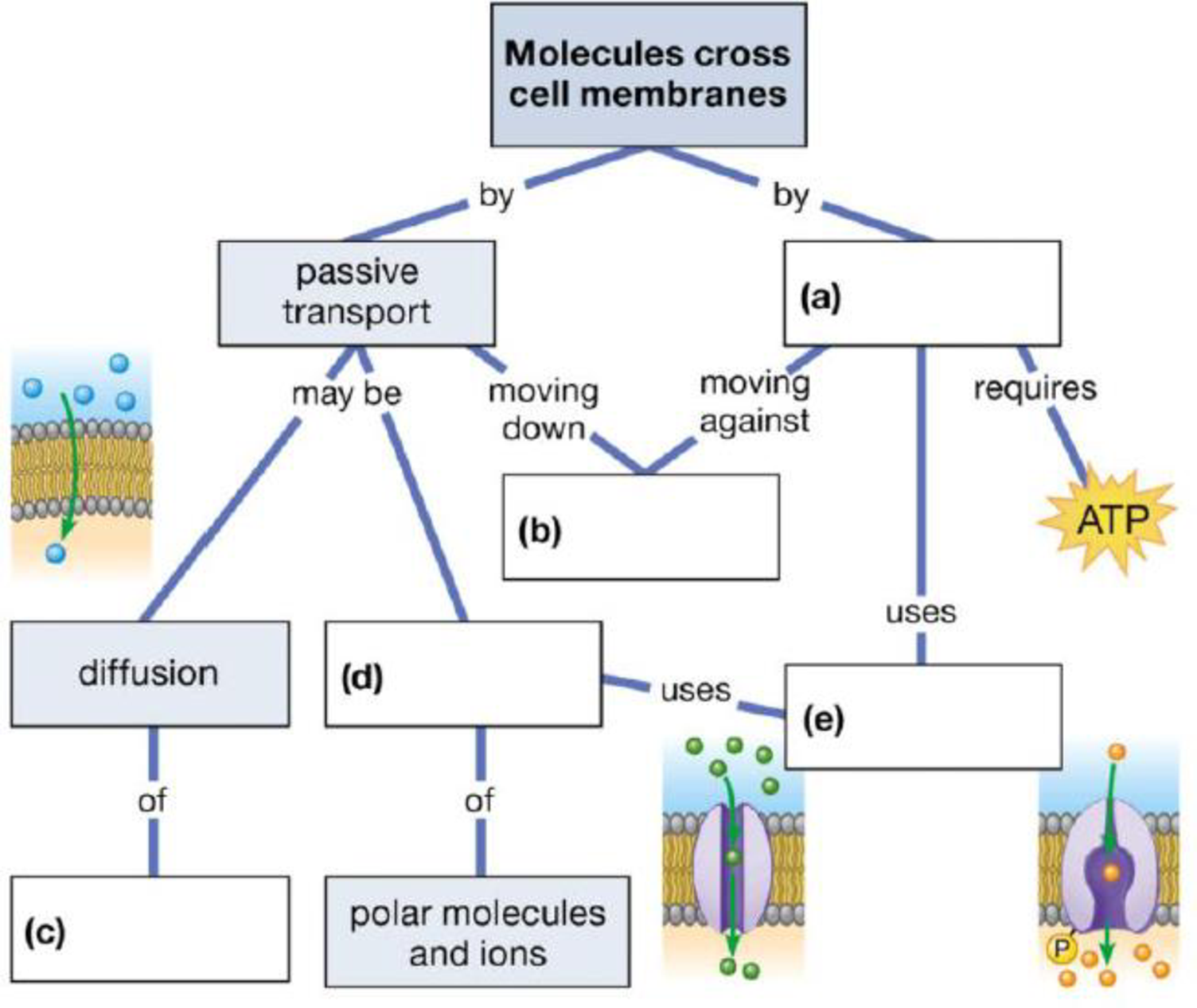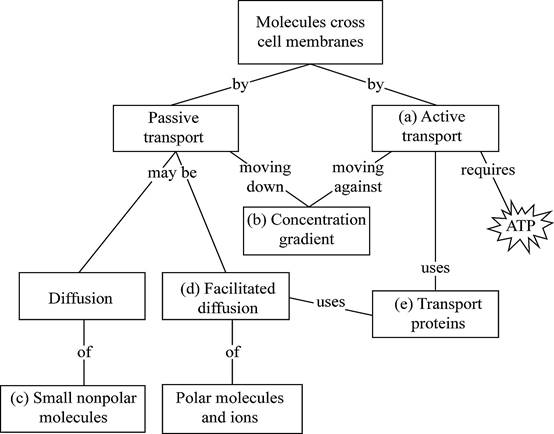
Concept explainers
Fill in the following concept map to review the processes by which molecules move across membranes.

To complete: The given map showing the process by which the molecules move across the cell membrane.
Introduction:
The plasma membrane is selectively permeable, and it allows the movement of substances in and out of the cells. The two main types of transport are active transport and passive transport.
Answer to Problem 1CC
Pictorial representation: The Fig.1 shows the movement of molecules between cells through the cell membranes.

Fig.1: The process involved in the transport of molecules across the cell membrane
Explanation of Solution
(a)
Correct answer: Active transport
Explanation: Active transport is an energy-dependent process in which the molecules are moved from a region of lower concentration to a region of higher concentration against their concentration gradient, and it requires energy in the form of ATP. Hence, the correct answer is Active transport.
(b)
Correct answer: Concentration gradient
Explanation: The concentration gradient is the difference in the concentration of the solutes. Active transport moves the molecules against their concentration gradient, whereas passive transport moves the solutes along with their concentration gradient. Hence, the correct answer is Concentration gradient.
(c)
Correct answer: Small nonpolar molecules
Explanation: A molecule is said to be nonpolar when there is a symmetrical arrangement of polar bonds in a complex molecule or if there is an equal sharing of electrons between the two atoms. These small nonpolar molecules can diffuse across the membrane. Example: Oxygen and carbon dioxide are the two nonpolar molecules that can undergo simple diffusion. Hence, the correct answer is Small nonpolar molecules.
(d)
Correct answer: Facilitated diffusion
Explanation: Facilitated diffusion is a passive transport where the molecules diffuse across the plasma membrane with the help of the membrane proteins such as carriers and channels. This transport does not require energy, and it moves the solute down the concentration gradient. Hence, the correct answer is Facilitated diffusion.
(e)
Correct answer: Transport proteins
Explanation: Transport proteins are a type of proteins used to move the substances across the cell membrane. They are mainly of two types: channel proteins and carrier proteins. Channel proteins are used to transport ions in and out of the cell, and carrier proteins are used to transport macromolecules, ions, and small molecules by changing their shape or conformation. Hence, the correct answer is Transport proteins.
Want to see more full solutions like this?
Chapter 5 Solutions
CAMP.BIO:CONC...MOD.MAST+PRINT>I<
- Every tutor here has got this wrong, don't copy off them.arrow_forwardSuppose that the population from question #1 (data is in table below) is experiencing inbreeding depression (F=.25) (and no longer experiencing natural selection). Calculate the new expected genotype frequencies (f) in this population after one round of inbreeding. Please round to 3 decimal places. Genotype Adh Adh Number of Flies 595 Adh Adh 310 Adhs Adhs 95 Total 1000 fladh Adh- flAdn Adh fAdhs Adharrow_forwardWhich of the following best describes why it is difficult to develop antiviral drugs? Explain why. A. antiviral drugs are very difficult to develop andhave no side effects B. viruses are difficult to target because they usethe host cell’s enzymes and ribosomes tometabolize and replicate C. viruses are too small to be targeted by drugs D. viral infections usually clear up on their ownwith no problemsarrow_forward
- This question has 3 parts (A, B, & C), and is under the subject of Nutrition. Thank you!arrow_forwardThey got this question wrong the 2 previous times I uploaded it here, please make sure it's correvct this time.arrow_forwardThis question has multiple parts (A, B & C), and under the subject of Nutrition. Thank you!arrow_forward
- Calculate the CFU/ml of a urine sample if 138 E. coli colonies were counted on a Nutrient Agar Plate when0.5 mls were plated on the NA plate from a 10-9 dilution tube. You must highlight and express your answerin scientific notatioarrow_forwardDon't copy off the other answer if there is anyarrow_forwardAnswerarrow_forward
- HAND DRAW There should be two proarrow_forwardMolecular Biology Question. Please help solve. Thanks. Please draw how two nucleotide triphosphates are linked together to form a dinucleotide, and label the 5' and 3' ends of the resulting dinucleotide.arrow_forwardWhat is a reversion in molecular biology?arrow_forward
 Human Physiology: From Cells to Systems (MindTap ...BiologyISBN:9781285866932Author:Lauralee SherwoodPublisher:Cengage Learning
Human Physiology: From Cells to Systems (MindTap ...BiologyISBN:9781285866932Author:Lauralee SherwoodPublisher:Cengage Learning Human Biology (MindTap Course List)BiologyISBN:9781305112100Author:Cecie Starr, Beverly McMillanPublisher:Cengage Learning
Human Biology (MindTap Course List)BiologyISBN:9781305112100Author:Cecie Starr, Beverly McMillanPublisher:Cengage Learning Concepts of BiologyBiologyISBN:9781938168116Author:Samantha Fowler, Rebecca Roush, James WisePublisher:OpenStax College
Concepts of BiologyBiologyISBN:9781938168116Author:Samantha Fowler, Rebecca Roush, James WisePublisher:OpenStax College Anatomy & PhysiologyBiologyISBN:9781938168130Author:Kelly A. Young, James A. Wise, Peter DeSaix, Dean H. Kruse, Brandon Poe, Eddie Johnson, Jody E. Johnson, Oksana Korol, J. Gordon Betts, Mark WomblePublisher:OpenStax College
Anatomy & PhysiologyBiologyISBN:9781938168130Author:Kelly A. Young, James A. Wise, Peter DeSaix, Dean H. Kruse, Brandon Poe, Eddie Johnson, Jody E. Johnson, Oksana Korol, J. Gordon Betts, Mark WomblePublisher:OpenStax College Biology: The Dynamic Science (MindTap Course List)BiologyISBN:9781305389892Author:Peter J. Russell, Paul E. Hertz, Beverly McMillanPublisher:Cengage Learning
Biology: The Dynamic Science (MindTap Course List)BiologyISBN:9781305389892Author:Peter J. Russell, Paul E. Hertz, Beverly McMillanPublisher:Cengage Learning





